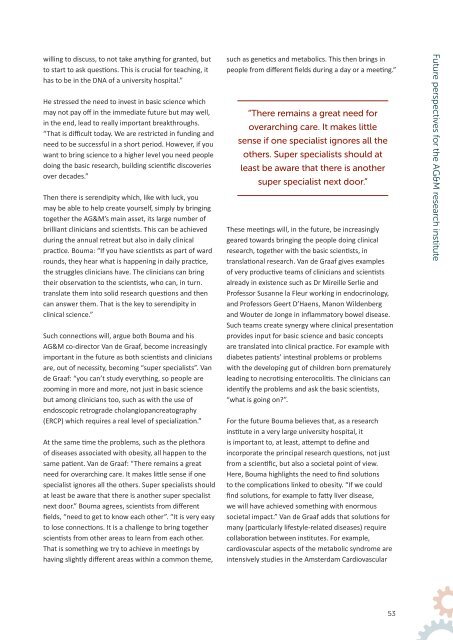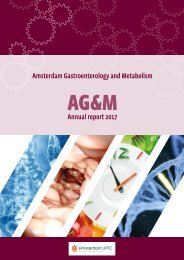AG&M annual report 2018
You also want an ePaper? Increase the reach of your titles
YUMPU automatically turns print PDFs into web optimized ePapers that Google loves.
willing to discuss, to not take anything for granted, but<br />
to start to ask questions. This is crucial for teaching, it<br />
has to be in the DNA of a university hospital.”<br />
He stressed the need to invest in basic science which<br />
may not pay off in the immediate future but may well,<br />
in the end, lead to really important breakthroughs.<br />
“That is difficult today. We are restricted in funding and<br />
need to be successful in a short period. However, if you<br />
want to bring science to a higher level you need people<br />
doing the basic research, building scientific discoveries<br />
over decades.”<br />
Then there is serendipity which, like with luck, you<br />
may be able to help create yourself, simply by bringing<br />
together the AG&M’s main asset, its large number of<br />
brilliant clinicians and scientists. This can be achieved<br />
during the <strong>annual</strong> retreat but also in daily clinical<br />
practice. Bouma: “If you have scientists as part of ward<br />
rounds, they hear what is happening in daily practice,<br />
the struggles clinicians have. The clinicians can bring<br />
their observation to the scientists, who can, in turn.<br />
translate them into solid research questions and then<br />
can answer them. That is the key to serendipity in<br />
clinical science.”<br />
Such connections will, argue both Bouma and his<br />
AG&M co-director Van de Graaf, become increasingly<br />
important in the future as both scientists and clinicians<br />
are, out of necessity, becoming “super specialists”. Van<br />
de Graaf: “you can’t study everything, so people are<br />
zooming in more and more, not just in basic science<br />
but among clinicians too, such as with the use of<br />
endoscopic retrograde cholangiopancreatography<br />
(ERCP) which requires a real level of specialization.”<br />
At the same time the problems, such as the plethora<br />
of diseases associated with obesity, all happen to the<br />
same patient. Van de Graaf: “There remains a great<br />
need for overarching care. It makes little sense if one<br />
specialist ignores all the others. Super specialists should<br />
at least be aware that there is another super specialist<br />
next door.” Bouma agrees, scientists from different<br />
fields, “need to get to know each other”. “It is very easy<br />
to lose connections. It is a challenge to bring together<br />
scientists from other areas to learn from each other.<br />
That is something we try to achieve in meetings by<br />
having slightly different areas within a common theme,<br />
such as genetics and metabolics. This then brings in<br />
people from different fields during a day or a meeting.”<br />
“There remains a great need for<br />
overarching care. It makes little<br />
sense if one specialist ignores all the<br />
others. Super specialists should at<br />
least be aware that there is another<br />
super specialist next door.”<br />
These meetings will, in the future, be increasingly<br />
geared towards bringing the people doing clinical<br />
research, together with the basic scientists, in<br />
translational research. Van de Graaf gives examples<br />
of very productive teams of clinicians and scientists<br />
already in existence such as Dr Mireille Serlie and<br />
Professor Susanne la Fleur working in endocrinology,<br />
and Professors Geert D’Haens, Manon Wildenberg<br />
and Wouter de Jonge in inflammatory bowel disease.<br />
Such teams create synergy where clinical presentation<br />
provides input for basic science and basic concepts<br />
are translated into clinical practice. For example with<br />
diabetes patients’ intestinal problems or problems<br />
with the developing gut of children born prematurely<br />
leading to necrotising enterocolitis. The clinicians can<br />
identify the problems and ask the basic scientists,<br />
“what is going on?”.<br />
For the future Bouma believes that, as a research<br />
institute in a very large university hospital, it<br />
is important to, at least, attempt to define and<br />
incorporate the principal research questions, not just<br />
from a scientific, but also a societal point of view.<br />
Here, Bouma highlights the need to find solutions<br />
to the complications linked to obesity. “If we could<br />
find solutions, for example to fatty liver disease,<br />
we will have achieved something with enormous<br />
societal impact.” Van de Graaf adds that solutions for<br />
many (particularly lifestyle-related diseases) require<br />
collaboration between institutes. For example,<br />
cardiovascular aspects of the metabolic syndrome are<br />
intensively studies in the Amsterdam Cardiovascular<br />
Future perspectives for the AG&M research institute<br />
53



